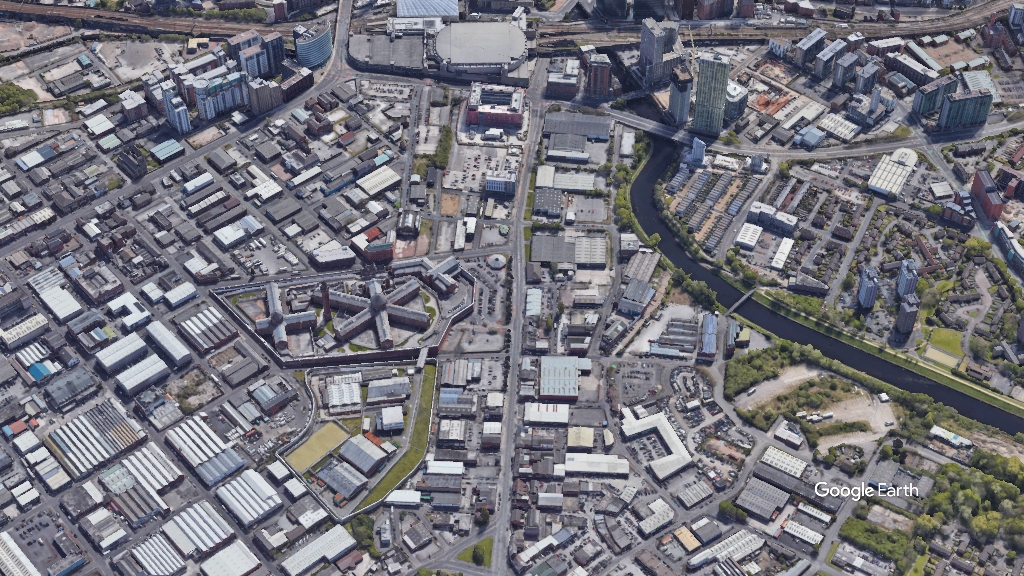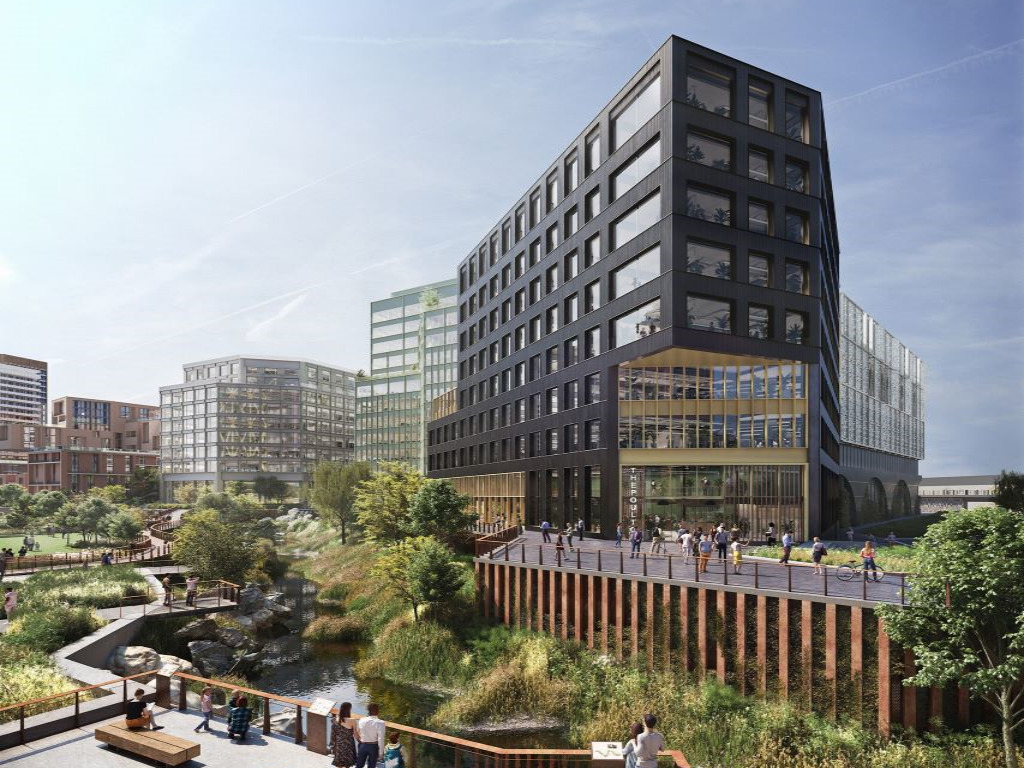Avison Young picked to lead Strangeways regeneration
A long-term plan to reimagine 320 acres across forgotten areas of Manchester and Salford has taken a step forward with the appointment of a seven-strong team of consultants.
Manchester City Council and Salford City Council have appointed Avison Young as lead consultant for the creation of the Strangeways and Cambridge Strategic Regeneration Framework, which is aimed at reimagining an area plagued by crime, poor quality built environment, and flooding issues.
Nicola Rigby, principal at Avison Young, said the SRF would be an “incredibly important piece of work”.
“The Strangeways and Cambridge area is one of the last pieces of the city fringe to be considered on a comprehensive basis, and a great example of the two cities combining to deliver meaningful change.
“It has the potential to be of national and international significance in terms of its scale and potential impact.”
AY will lead a team that also features:
- Maccreanor Lavington – masterplanning and urban design lead
- Feilden Clegg Bradley – architecture and heritage
- Schulze-Grassov – landscape design and public realm
- Civic Engineers – movement and highways
- Useful Projects – zero carbon strategy
- Placed – community engagement
The multi-disciplinary team will draw up a 10-year vision for the area aimed at guiding its long-awaited transformation. The SRF will be considered by the councils’ executive committees next summer.
In July, Place North West revealed that Manchester City Council and Salford City Council would team up for the regeneration of Strangeways and Cambridge, a largely industrial area of Salford.
The councils have long recognised the growth potential of the area, which is located on the fringes of Manchester city centre, where demand for both homes and commercial space is high.
Leader of the Manchester City Council, Bev Craig said Strangeways is a “priority” for investment in the coming years.
“We know there is huge potential here, and this regeneration framework is a statement of intent that we are committed to realising the untapped value of this neighbourhood.
“We now want to see a plan that supports the area’s existing employment base, whilst also setting out an ambitious low-carbon development programme that will deliver new homes, quality public realm, and new commercial spaces that can support businesses to grow and invest in the area.”
One of the biggest barriers to regeneration in the SRF area is HMP Manchester, the prison previously known as Strangeways.
Manchester City Council has repeatedly asked the Ministry of Justice to relocate the facility elsewhere but there are no current plans in place for this.
Moving the prison out of Strangeways would free up a large chunk of land off Great Ducie Street.
However, due to a lack of movement on the relocation plans, the SRF will be drawn up “based on the current Strangeways neighbourhood, including the prison in situ”, a Manchester City Council spokesperson said earlier this year.
The SRF could be updated to respond to any decision made by the MoJ about the future of the prison.
The location of the prison is not the only issue Manchester City Council is facing in Strangeways.
The area off Great Ducie Street around HMP Manchester has suffered from serious issues relating to crime for several years, including the trade of counterfeit goods.
An ongoing Greater Manchester Police operation, Operation Vulcan, is aimed at cleaning up the area. So far 200 counterfeit shops have been shut down and more than 1,000 tonnes of counterfeit items repurposed and recycled, according to GMP.
“Following months of intensive operations between the city council, GMP and other agencies, we have worked to remove the criminal enterprises that have undermined the reputation of the area and limited the chance for existing legitimate businesses to prosper,” Craig said.
The surrounding context
A strategic regeneration framework for the adjacent Great Ducie Street zone already exists and was adopted by Manchester City Council in 2018.
This framework, which outlines plans for 2.8m sq ft of commercial space, did not incorporate the prison site, while the refreshed SRF will.
Several projects have come forward off the back of the Great Ducie Street masterplan.
The Manchester College’s £93m city centre campus on the former Boddington’s Brewery recently completed, Latimer has started construction of a 461-home development on an adjoining plot, and Salboy picked up the stalled Old Brewery Gardens development late last year and is on site.
Salford’s opportunity
While the Great Ducie Street SRF is a purely Manchester project, the Strangeways and Cambridge SRF takes a cross-border approach, with a forgotten area of Salford in line to benefit.
Salford City Council hopes the SRF will “address longstanding environmental issues” related to the Cambridge area’s high risk of flooding.
Tender documents for the SRF opportunity said that demand for new homes and commercial space in the Cambridge is high due to its fringe city centre location.
However, at present the risk of flooding “has an impact on the existing homes and businesses as well as constraining future redevelopment”.
Salford City Mayor, Paul Dennett, said: “This is an important step in the right direction to strategically plan for the future of regeneration and development in a previously over-looked part of Salford and Manchester.
“It’s an obvious missing piece of the jigsaw when we think about the on-going development of our city and our aspirations to create connected and sustainable communities.”
Dennett has thrown down the gauntlet to the appointed consultancy team.
“Ultimately, the goal here is to establish a framework that meets the needs and aspirations of both Salford and Manchester, while also creating an attractive and sustainable proposition for businesses and local residents.
“We need to ensure that the framework provides as clear vision for how the development will breathe new life into this area, supporting residents and communities in the delivery of sustainable communities, embedding low-carbon principles into any forthcoming development and regeneration, creating quality public realm, while also supporting existing and new business to thrive.”





Fantastic to see none of the bland & stale architecture practices we’ve become used to in Manchester over the years!!
By Anonymous
This can double the size of the city centre all by itself. A lot of potential here!
By Anonymous
I think for the city centre to thrive the Mancunian way needs to go. It cuts off the centre from the surrounding areas and needs to be put underground with a park built on top of it.
By Anonymous
I think it’s absolutely imperative that whatever the masterplan entails, it makes maximum use of the river frontage and hopefully provides the city a new park (on par with Mayfield in size at the very least) on the bend of the river.
By Anonymous
Make this area full of skyscrapers and green spaces, effectively an extension to the city centre that can house 100,000+!
By MC
That’s a huge area and clearly a long time scale but really good to see who’s involved.
By Tom
@anonymous 11:55. No way should huge domes of public money be spent burying any roads. That money should be spent on building reliable public transport so people get out of their cars. Tunnel Metrolink not the ring road. Plus as someone who lives in Ancoates and crosses the ring rose several times a day this idea it is a barrier is false. Ancoates is booming. Everyone who lives here is generally well able to cross a road.
By J
Not all just skyscrapers though anon, I’d love to see roads lines with 6-10 story medium density mansion/euroblock style, mixed used buildings with some taller buidings and green spaces in between
By Anonymous
Ultimate fantasy project for the area being the reconstruction of the assizes court building but that is very unlikely sadly 🙁
By Anonymous
Like I said, the concrete monster has to be fed to keep those in luxury, but do not even live in the area
By Anonymous
Keep the prison close to the Courts. Net zero and all that. Rather the prison than the cheapest, blandest tower blocks you can build.
By Anonymous
It will be interesting to see how the listed prison can be integrated into the regeneration plans and balance density and height to respect this. Its one of the key gateways into the city and the regeneration needs careful thought, design and intervention. They key will be a relocation of the prison but given its already full and with not enough capacity some serious thought needs to be had on where it goes to and how long that will take to procure assuming they will move
By C Salvador
A mammoth task. To be honest with a few exceptions the place needs flattening. Driving down Cheetham Hill Road is a grim experience.
By Elephant
There are a lot of interesting buildings in that area, Manchester Ice Palace etc, that really should be preserved to make this more than just a generic bland load of dullness that could well need overhauling itself in 30/40 years time. Need to develop this area a little differently than others. Also will need a rethink on the Arena as that is currently just a giant blank façade that acts a a barrier to the city centre. It will need more than just letting the usual suspects chuck random towers up here and there and crossing fingers that it works.
By Loganberry
It’s disgraceful that it was allowed to get like this in the first place
By Gilly
There is a strong industrial character and street pattern which i think should form the context to design principles, this can really be a distinctive human scale neighbourhood/district, with squares, plenty of active frontages and nice facades that aren’t glass or grey,hopefully it’ll look more like Ancoats and not like Great Jackson’s/Deansgate Square
By Human Scale
Where will people park when visiting the Arena when all this land gets developed?
By Bentley Driver
I hope this will create employment and solve the problem of affordable housing for the community
By Anonymous
@Bentley Driver, That’s their problem, this is a central location, and the provisions for decent homes far outweighs the parking needs of occasional concertgoers, they will either have to take public transport, many do, or park at a parking somewhere further away, there probably will be some multi-storey car parks, but they can kiss goodbye to the cheap and sketchy quarters in Strangeways/Cheetham Hill.
By Anonymous
Seems a long overdue project and great to see the optimism and flexibility around working with what cannot be changed. Avison Young is a great choice.
By Ranu